Do the Math
The overwhelming majority of scientists agree that we must keep global warming below two degrees Celsius through 2100 to avoid the worst effects of climate change. Achieving that goal requires limiting emissions, and doing so quickly. Without additional action, greenhouse gases will continue to grow for the foreseeable future.
Climate change is caused by the total amount of carbon in the atmosphere, so thinking about emissions in terms of cumulative totals rather than annual totals provides an accurate picture of the challenge. This website and book focus on the cumulative reductions necessary by 2050, instead of all the way to 2100, because the further the horizon, the more uncertain the predictions. Although climate models vary, they generally agree that in order to stay below the two-degrees Celsius target, to the world must reduce total cumulative emissions by 25% to 55% below business as usual levels by 2050.
This analysis relies on modeling completed in 2013 as part of the Low Climate Impact Scenarios and the Implications of Required Tight Emissions Control Strategies (LIMITS) exercise. In particular, it relies on modeling done by the Pacific Northwest National Laboratory and Joint Global Change Research Institute using the Global Change Assessment Model, evaluating emissions between 2010 and 2050. The LIMITS study results suggest that for a 50% shot at staying under two degrees of warming, the world must reduce cumulative greenhouse gas emissions by at least 41% between 2010 and 2050.
The Paris Agreement is a good first step to achieving this goal, though it still falls short of necessary mid-century emissions reductions. But more importantly, the Paris Agreement is not a plan for achieving those reductions – it is simply a target countries have agreed to. The key then, is translating those pledges into reductions. The way to win on climate is properly designing and implementing 10 proven policies in the 20 countries responsible for 75% of global emissions.
Avoiding the Worst Impacts of Climate Change
The level of atmospheric greenhouse gases is measured in parts per million (ppm), or the number of greenhouse gas particles per million particles in the atmosphere. The impact of gases other than carbon dioxide is measured by equating those gases to an equivalent amount of carbon dioxide (CO2), called carbon dioxide equivalent (CO2e). The equivalence of gases ranges widely. For example, one molecule of methane equals about 30 molecules of carbon dioxide, whereas other chemicals such as fluorinated gases, used primarily as refrigerants, are thousands of times more potent than carbon dioxide per molecule. Notably, the equivalence value varies based on the timeframe over which the gas is evaluated (methane has a higher equivalence over 20 years than over 100 years, for example) and as the science of climate change advances. The total amount of CO2e in the atmosphere includes CO2 as well as all the other gases that contribute to climate change.
There is broad consensus that preventing the worst impacts of climate change requires keeping global warming below two degrees Celsius through the end of the 21st century. To have at least a 50/50 chance of limiting warming to two degrees, we must limit concentrations of CO2e to 500 ppm by 2100, although some overshoot of this target in previous years is okay. Yet in 2015, CO2e concentrations measured 485 ppm, and they have been increasing at a rate of two to four parts per million per year. To achieve the 500 ppm target by 2100, immediate on-the-ground action is needed. But what does this mean in terms of emissions?
Climate change and the warming that drives it are a function of the total amount of carbon in the atmosphere. In other words, it is a stock problem, not a flow problem, as discussed in the Introduction. Therefore, it is useful to think of emissions, and necessary emission reductions, in terms of cumulative totals rather than annual amounts. Significant action to reduce emissions will be needed throughout the 21st century, but for simplicity and given the growing uncertainty in years further out, we focus on the necessary reductions between now and 2050.
Without additional action to reduce greenhouse gas emissions, just over two trillion tons of CO2e will be emitted between 2016 and 2050. Although climate models vary, they show that in order to meet the 500 ppm target, cumulative total emission reductions of 25% to 55% relative to a business-as-usual scenario are necessary between 2016 and 2050.
For this book, we rely on modeling completed in 2013 as part of the Low Climate Impact Scenarios and the Implications of Required Tight Emissions Control Strategies (LIMITS) exercise. In particular we rely on the modeling done by Pacific Northwest National Laboratory and the Joint Global Change Research Institute using the Global Change Assessment Model, evaluating emissions between 2016 and 2050.
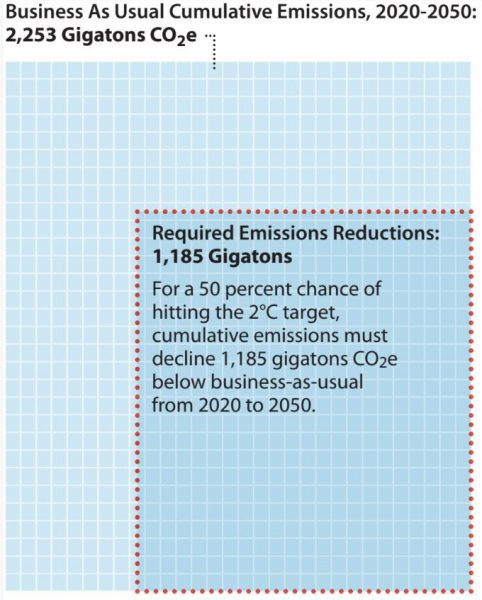 The results of the LIMITS study suggest that to have a 50/50 shot at staying under two degrees of warming we need to reduce cumulative greenhouse gas emissions by at least 41% between 2010 and 2050.
The results of the LIMITS study suggest that to have a 50/50 shot at staying under two degrees of warming we need to reduce cumulative greenhouse gas emissions by at least 41% between 2010 and 2050.
This value is global; emission reductions needed from individual countries will vary, depending on their development status. For example, the most industrialized countries will need to achieve significantly deeper reductions than the 41% global number to compensate for other emerging economies with high rates of economic development.
It’s also worth noting that a 41% reduction in cumulative emissions entails much greater annual emission reductions in later years as emission reductions are phased in. In 2050, global annual emission reductions of 65% relative to business-as-usual will be necessary, with the more economically developed regions needing to achieve reductions of 70% or more.
This website and book evaluate potential reductions at a global scale. According to the Global Change Assessment Model results discussed earlier, we need cumulative greenhouse gas emission reductions of just over 40% between 2010-2050 relative to business as usual to give ourselves a 50/50 shot at staying under two degrees of warming. This is the target we aim for.
The Paris Accord: A Good First Step
In December 2015, 189 countries responsible for nearly 99% of the world’s greenhouse gas emissions signed the Paris Agreement, in which they agreed to make an effort to limit emissions over the next 10-30 years. The centerpiece of the Paris Agreement is each country’s specific emission reductions targets.
If the targets are all met, they would collectively move emissions a good share of the way to the two-degree pathway. The Paris Agreement commitments, on their own, move the emission curve about a third of the way to the two-degree pathway relative to business-as-usual. If existing policies and the Paris pledges are extended to 2100 with the same degree of effort, the emission curve moves about 80% of the way to the two-degree pathway. Despite the United States’ decision to withdraw from the Paris Agreement, commitments from remaining countries still cover more than 80% of the world’s emissions today. Furthermore, U.S. states, cities, and businesses have expressed their commitment to meeting emission reduction targets, which will help reduce U.S. emissions.
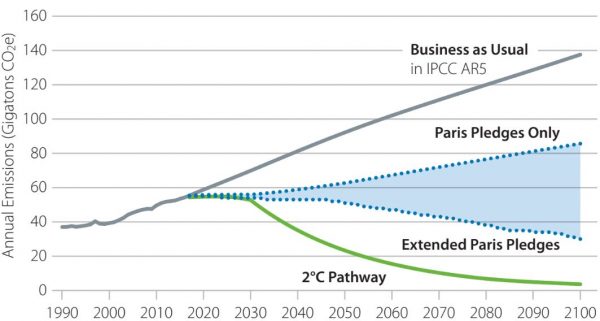
Pledges made as part of the Paris Agreement get us part way to the 2°C Pathway. Source: Climate Interactive and Climate Action Tracker.
The commitments enshrined in the Paris Agreement represent a significant diplomatic accomplishment and provide a very important impetus to move the global economy in the right direction. However, the existing commitments do not themselves add up to the two-degree pathway. And, perhaps more importantly, the pledges on their own will not result in on-the-ground emission reductions. Domestic policy is needed to drive change in the power plants, factories, buildings, vehicles, and forests. These shortcomings raise two important questions:
- How can policymakers close the gap between the existing Paris commitments and the two-degree pathway?
- How can policymakers translate the targets into real-world emission reductions?
Focus on the Highest Emitting Countries
Although the Paris Agreement encompasses nearly 99% of global emissions (not including the proposed U.S. withdrawal, which drops it down to about 82%), just 20 countries account for nearly 75% of global greenhouse gas emissions. The top 20 emitting countries all submitted pledges in 2015 (although, as noted, the U.S. has announced its withdrawal since then), but many of these countries have the potential to significantly strengthen their commitments.
For example, Climate Action Tracker, an independent group that tracks and evaluates climate policy, rates the following countries’ pledges as “Inadequate”: Russia (4th largest emitter), Indonesia (5th largest emitter), Japan (7th largest emitter), Canada (8th largest emitter), Australia (12th largest emitter), South Korea (13th largest emitter), and South Africa (17th largest emitter). Even the two largest emitters, China and the U.S., have only “Medium” ratings for their pledges. The weak contributions from many of the top-emitting countries, including four of the top ten, suggest that targeting these countries for additional reductions could make a positive impact on global emissions and help move global commitments closer to the two-degree pathway.
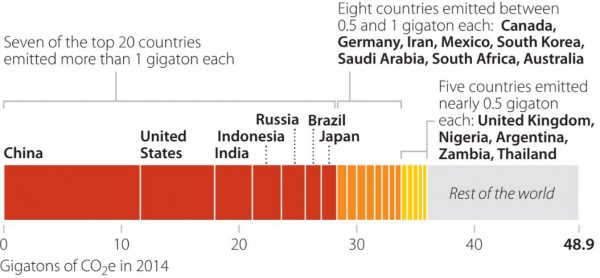
The top 20 emitting countries are responsible for roughly 75% of global emissions. Source: World Resources Institute.
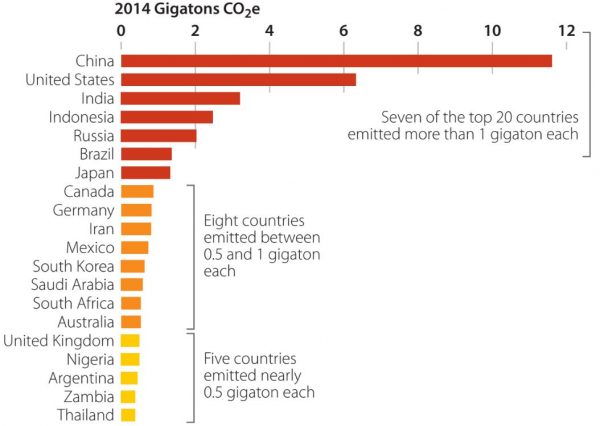
Emissions vary widely in the top 20 emitting countries, dominated by China and the U.S. Source: World Resources Institute.
Energy and Industrial Processes Drive Greenhouse Gas Emissions
The second and perhaps more important question is: How do countries translate pledges, which are simply high-level emission targets, into actionable policy that will achieve real-world emission reductions? Answering this question requires an assessment of what sources are responsible for greenhouse gas pollution.
Energy and industrial process (including agriculture and waste) emissions are by far the largest driver of CO2e emissions globally. Energy-related emissions account for just under 74% of global emissions, and industrial processes account for nearly 20%. Together, they total nearly 94% of global greenhouse gas emissions. In some countries, such as Indonesia, Brazil, and Nigeria, deforestation and other land use change emissions are significant sources of greenhouse gases.
The sources of industrial process emissions are well documented, and given the fact that energy is the largest source of greenhouse gas emissions, the next logical question becomes: What drives energy-related greenhouse gas emissions?
Energy-related greenhouse gas emissions are concentrated in the electricity, transportation, building, and industry sectors, with power plants generally being the largest source. These emissions come primarily from burning coal and natural gas to create power and heat and burning petroleum products to power vehicles.
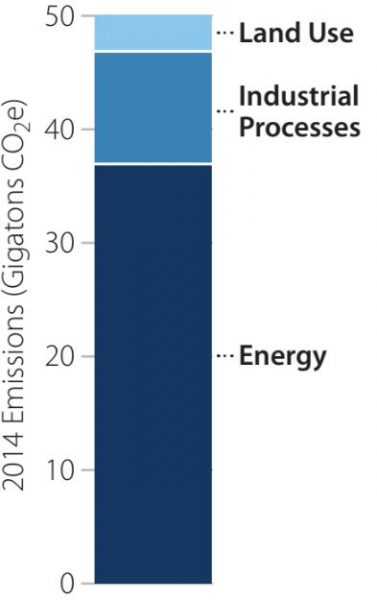
CO2e emissions are primarily from energy and industrial processes. Source: World Resources Institute.
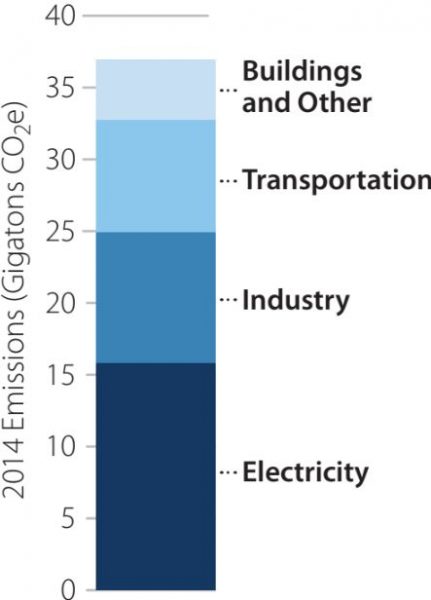
Energy and industrial process CO2 emissions are fairly evenly spread across the electricity, industry, transportation, and buildings sectors. Source: World Resources Institute.
Roadmap to a Low-Carbon Future: Focus on Biggest Sources in Top Countries
The sector-by-sector math of CO2e emissions, overlaying the 20 countries that are the largest sources, sheds light on where to focus efforts. Quite literally, there is no path to a low-carbon future other than the list below. Every policy idea must be measured against its contribution to one or more of these goals.
Reduce Electricity Demand in the Buildings and Industry Sectors
Demand for electricity is driven by buildings and industry, and increasing their efficiency is a large-scale, cost-effective strategy. Efficiency is typically the most cost-effective way of reducing emissions, with initial investments paying dividends for years via reduced fuel costs.
Reduce the Carbon Intensity of Electricity Generation
Electricity sector emissions can also be lowered by reducing the carbon intensity of electricity generation. Using fossil-free technologies such as wind, solar, hydro, geothermal, and nuclear to generate electricity can avoid the emissions (and also the air quality problems) that come from burning fossil fuels such as coal and natural gas.
Reduce Transportation Emissions Through Efficiency, Electrification, and Urban Mobility
The transportation sector is a large and growing source of greenhouse gas emissions. The top ways to reduce pollution from transportation are to improve vehicle fuel economy, electrify vehicles (and to simultaneously reduce the carbon intensity of electricity generation), and provide alternatives to personal vehicle travel via smart urban planning and public transit.
Reduce Non-Electricity Industry Sector Emissions
Non–electricity industry sector emissions are another large source of greenhouse gas emissions. These include primarily industrial process emissions (e.g., the chemical processes involved in cement manufacturing or natural gas venting and flaring) but also energy used for heat, as in the iron and steel industry.
Reduce Deforestation and Forest Degradation in Tropical Forest Nations
In tropical forest nations where a large share of emissions come from land use, land use change, and forestry, policymakers should aim to reduce deforestation and forest degradation. A handful of options exist to achieve these goals, including legally protecting forests through the creation of designated protected areas, payments to landowners for providing ecosystem services, and payments to landowners to remove forested land from timber production.
Although land use is an important sector for emission reductions, this website and book focus on energy and industrial process emission reductions. The science, the policies, and the actors for reducing emissions from land use are very different from those for energy and industrial processes, and they deserve separate treatment from experts in land use policy.
Conclusion
The Paris Agreement targets, if fully achieved, get us about one-third of the way to the two-degree goal, meaning further reductions will be necessary. But more important, the commitments under the Paris Agreement are targets, and unless they are converted into highly effective, sector-specific national policies, they will achieve little. The aim of this book is to help guide that process.
The starting point is to evaluate where emissions are coming from. Energy and industrial processes are the dominant sources of greenhouse gas emissions in most economies. Within the energy sector, emissions are evenly spread across the electricity, industry, transportation, and building sectors. This assessment suggests that to reduce emissions, policymakers need to focus on reducing electricity demand in the industry and building sectors, reducing the carbon intensity of electricity generation, improving the efficiency of vehicles while providing cleaner alternatives, and reducing process emissions in the industry sector. In certain economies, a strong focus on reducing emissions from land use change is also necessary.
Now that we know what we need to do reduce emissions, the next question is: How do we achieve these goals? To examine this question, we turn next to the four essential types of energy policy.